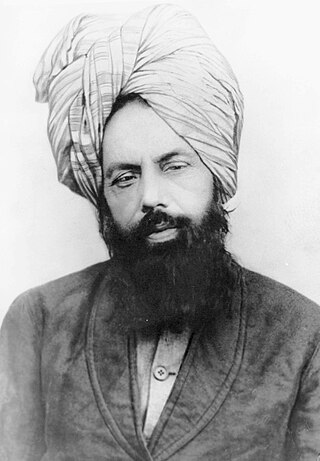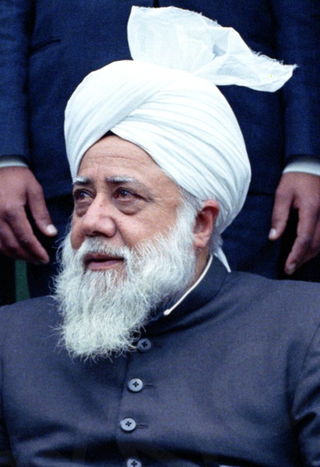Related Research Articles

Mirza Ghulam Ahmad was an Indian religious leader and the founder of the Ahmadiyya movement in Islam. He claimed to have been divinely appointed as the promised Messiah and Mahdī—which is the metaphorical second-coming of Jesus (mathīl-iʿIsā), in fulfillment of the Islamic prophecies regarding the end times, as well as the Mujaddid of the 14th Islamic century.

Ahmadiyya Islam considers Jesus (ʿĪsā) as a mortal man, entirely human, and a prophet of God born to the Virgin Mary (Maryam). Jesus is understood to have survived the crucifixion based on the account of the canonical Gospels, the Qurʾān, hadith literature, and revelations to Mirza Ghulam Ahmad. Having delivered his message to the Israelites in Judea, Jesus is understood to have emigrated eastward to escape persecution from Judea and to have further spread his message to the Lost Tribes of Israel. In Ahmadiyya Islam, Jesus is thought to have died a natural death in India. Jesus lived to old age and later died in Srinagar, Kashmir, and his tomb is presently located at the Roza Bal shrine.

The Lahore Ahmadiyya Movement for the Propagation of Islam, is a separatist group within the Ahmadiyya movement that formed in 1914 as a result of ideological and administrative differences following the demise of Hakim Nur-ud-Din, the first Caliph after Mirza Ghulam Ahmad. Members of the Lahore Ahmadiyya movement are referred to by the majority group as ghayr mubāyi'īn and are also known colloquially as Lahori Ahmadis.

Abū Dāwūd (Dā’ūd) Sulaymān ibn al-Ash‘ath ibn Isḥāq al-Azdī al-Sijistānī, commonly known as Abū Dāwūd al-Sijistānī, was a scholar of prophetic hadith who compiled the third of the six "canonical" hadith collections recognized by Sunni Muslims, the Sunan Abu Dāwūd.

Al-Masih ad-Dajjal, otherwise referred to simply as the Dajjal, is an evil figure in Islamic eschatology who will pretend to be the promised Messiah and later claim to be God, appearing before the Day of Judgment according to the Islamic eschatological narrative. The word Dajjal is not mentioned in the Quran, but he is mentioned and described in the Hadith. Corresponding to the Antichrist in Christianity, the Dajjal is said to emerge out in the East, although the specific location varies among the various sources.

Mirza Nasir Ahmad was the third Caliph of the Ahmadiyya Muslim Community. He was elected as the third successor of Mirza Ghulam Ahmad on 8 November 1965, the day after the death of his predecessor and father, Mirza Basheer-ud-Din Mahmood Ahmad.

Mirza Basheer-ud-Din Mahmood Ahmad was the second caliph, leader of the worldwide Ahmadiyya Muslim Community and the eldest son of Mirza Ghulam Ahmad from his second wife, Nusrat Jahan Begum. He was elected as the second successor of Mirza Ghulam Ahmad on 14 March 1914 at the age of 25, the day after the death of his predecessor Hakim Nur-ud-Din.

Seal of the Prophets, is a title used in the Qur'an and by Muslims to designate the Islamic prophet Muhammad as the last of the prophets sent by God.

Dakota Staton was an American jazz vocalist who found international acclaim with the 1957 No. 4 hit "The Late, Late Show". She was also known by the Muslim name Aliyah Rabia for a period due to her conversion to Islam as interpreted by the Ahmadiyya Muslim Community.

The Fazl Mosque also known as The London Mosque, is the first purpose-built mosque in London, England. It was opened on 23 October 1926 in Southfields, Wandsworth. At a cost of £6,223, the construction of the mosque and the purchase of the land on which it stands, was financed by the donations of Ahmadi Muslim women in Qadian, Punjab, British India, with support from the British Muslim convert Khalid Sheldrake. Between 1984 and 2019 the Fazl Mosque was the residence of the caliphs of the Ahmadiyya Muslim Community, and therefore its de facto international headquarters. The administrative headquarters now lies at the site of the Islamabad, Tilford.

Mirza Masroor Ahmad is the current and fifth leader of the Ahmadiyya Muslim Community. His official title within the movement is Fifth Caliph of the Messiah. He was elected on 22 April 2003, three days after the death of his predecessor Mirza Tahir Ahmad.

The Baitul Huda Mosque is a mosque located in the Sydney suburb of Marsden Park, in New South Wales, Australia. The mosque is run by the Ahmadiyya Muslim Community (AMC).

Ahmadiyya, officially the Ahmadiyya Muslim Community or the Ahmadiyya Muslim Jama'at, is an Islamic revival or messianic movement originating in British India in the late 19th century. It was founded by Mirza Ghulam Ahmad (1835–1908), who claimed to have been divinely appointed as both the Promised Mahdi and Messiah expected by Muslims to appear towards the end times and bring about, by peaceful means, the final triumph of Islam; as well as to embody, in this capacity, the expected eschatological figure of other major religious traditions. Adherents of the Ahmadiyya—a term adopted expressly in reference to Muhammad's alternative name Aḥmad—are known as Ahmadi Muslims or simply Ahmadis.

The Ahmadiyya Muslim Community is the second-largest sect of Islam in Sierra Leone, behind only Sunni Islam. The earliest history of the Community in Sierra Leone dates back to the early period of the Second Caliphate, when at least six people are said to have conveyed their adherence to the faith. The sect attained rapid growth in the country after the 1937 arrival of Nazir Ahmad Ali, the first permanent Ahmadi missionary in Sierra Leone. Recent estimates by Ahmadi community suggest that there are approximately 560,000 Ahmadi Muslims in Sierra Leone, which is about 9% of the country's total population. Sierra Leone has the largest percentage of Ahmadi Muslims by share of total population in the world.
African-American Muslims, also colloquially known as Black Muslims, are an African American religious minority. African American Muslims account for over 20% of American Muslims. They represent one of the larger minority Muslim populations of the United States as there is no ethnic group that makes up the majority of American Muslims. They are represented in Sunni and Shia denominations as well as smaller sects, such as the Nation of Islam. The history of African-American Muslims is related to African-American history in general, and goes back to the Revolutionary and Antebellum eras.

Ahmadiyya is an Islamic branch in the United States. The earliest contact between the American people and the Ahmadiyya movement in Islam was during the lifetime of Mirza Ghulam Ahmad. In 1911, during the era of the First Caliphate of the Community, the Ahmadiyya movement in India began to prepare for its mission to the United States. However, it was not until 1920, during the era of the Second Caliphate, that Mufti Muhammad Sadiq, under the directive of the caliph, would leave England on SS Haverford for the United States. Sadiq established the Ahmadiyya Muslim Community in the United States in 1920. The U.S. Ahmadiyya movement is considered by some historians as one of the precursors to the Civil Rights Movement in America. The Community was the most influential Muslim community in African-American Islam until the 1950s. Today, there are approximately 15,000 to 20,000 American Ahmadi Muslims spread across the country.

Ahmadiyya, called Ahmadis is a community under the leadership of the caliph in London. The earliest history of the Community in the country begins in 1956, during the Second Caliphate, when Kamal Yousuf was appointed as the head of the mission in Sweden. However it was not until 1970 that the Community was first officially registered. Today, there are two purpose-built mosques, one of which is the oldest in the country, and also a number of other centers, representing an estimated average of 1600 Ahmadis in the country.

Ahmadiyya is an Islamic movement in Australia, first formally founded in the country in the 1980s, during the era of the fourth caliph. However, the history of the Community dates back to the early 20th century, during the lifetime of the founder of the movement, Mirza Ghulam Ahmad, with the first contacts arising as a consequence of Australians travelling to British India, and also as a consequence of early, "Afghan" camel drivers settling in Australia during the mid to late 19th century. Today there are at least four Ahmadi mosques in four of the six Australian states, representing an estimated 6,000-8,000 Australian Ahmadis in the country.

Ahmadiyya is an Islamic religious movement in Liberia. Founded in the year 1956, during the era of the Second Caliphate, the movement today represents an estimated 10% of the country's Muslim population. Approximately, this corresponds to 85,000 Ahmadi Muslims in Liberia. Current National President is Maulvi Naveed Ahmad Aadil.
References
- ↑ Cf. Robert Dannin: Black Pilgrimage to Islam. New York: Oxford University Press, 2002, S. 58
- ↑ Tom Lord Jazz Discography.
- ↑ "MALCOLMOLOGY 101, #18: NOI ANSWERS MUSLIM CRITICS", Malcolm X: A Life of Reinvention, March 14, 2011.